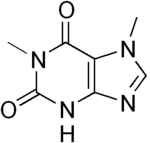Paraxanthine

| |

| |
| Names | |
|---|---|
| IUPAC name
1,7-dimethyl-3H-purine-2,6-dione
| |
| Other names
paraxanthine,
1 ,7-Dimethylxanthine | |
| Identifiers | |
3D model (JSmol)
|
|
| ChEBI | |
| ChEMBL | |
| ChemSpider | |
| ECHA InfoCard | 100.009.339 |
PubChem CID
|
|
| UNII | |
CompTox Dashboard (EPA)
|
|
| |
| |
| Properties | |
| C7H8N4O2 | |
| Molar mass | 180.167 g·mol−1 |
| Melting point | 351 to 352 °C (664 to 666 °F; 624 to 625 K) |
Except where otherwise noted, data are given for materials in their standard state (at 25 °C [77 °F], 100 kPa).
| |
Paraxanthine, or 1,7-dimethylxanthine, is a dimethyl derivative of xanthine, structurally related to caffeine. Like caffeine, paraxanthine is a psychoactive central nervous system (CNS) stimulant. It possesses a potency roughly equal to that of caffeine and is likely involved in the mediation of the effects of caffeine itself.
Production and metabolism
Paraxanthine is not produced by plants and is only observed in nature as a metabolite of caffeine and theobromine in animals. After intake, roughly 84% of caffeine is demethylated at the 3-position to yield paraxanthine, making it the chief metabolite of caffeine in the body.[1]
Certain proposed synthetic pathways of caffeine make use of paraxanthine as a bypass intermediate. However, its absence in plant alkaloid assays implies that these are infrequently, if ever, directly produced by plants.[citation needed]
Physiological effects
Paraxanthine has a number of physiological effects on animals:
- Paraxanthine is a competitive nonselective phosphodiesterase inhibitor[2] which raises intracellular cAMP, activates PKA, inhibits TNF-alpha[3][4] and leukotriene[5] synthesis, and reduces inflammation and innate immunity.[5]
- Paraxanthine is a nonselective adenosine receptor antagonist[6] which raises plasma epinephrine and diastolic blood pressure.
- Paraxanthine is responsible for the lipolytic properties of caffeine, and its presence in the blood causes an increase in serum free fatty acid concentration. [citation needed]
- Paraxanthine, unlike caffeine, acts as an enzymatic effector of Na+/K+ ATPase. As a result, it is responsible for increased transport of potassium ions into skeletal muscle tissue. Similarly, the compound also stimulates increases in calcium ion concentration in muscle.[citation needed]
Toxicity
Paraxanthine is believed to exhibit a lower toxicity than caffeine.[7] While blood levels commensurate with average intake appear to be fairly innocuous, high blood concentrations of paraxanthine have been linked to miscarriage in pregnant mothers.[8]
References
- ^ Guerreiro S, Toulorge D, Hirsch E, Marien M, Sokoloff P, Michel PP (October 2008). "Paraxanthine, the primary metabolite of caffeine, provides protection against dopaminergic cell death via stimulation of ryanodine receptor channels". Mol. Pharmacol. 74 (4): 980–9. doi:10.1124/mol.108.048207. PMID 18621927.
- ^ Essayan DM. (2001). "Cyclic nucleotide phosphodiesterases". J Allergy Clin Immunol. 108 (5): 671–80. doi:10.1067/mai.2001.119555. PMID 11692087.
- ^ Deree J, Martins JO, Melbostad H, Loomis WH, Coimbra R (2008). "Insights into the Regulation of TNF-α Production in Human Mononuclear Cells: The Effects of Non-Specific Phosphodiesterase Inhibition". Clinics (Sao Paulo). 63 (3): 321–8. doi:10.1590/S1807-59322008000300006. PMC 2664230. PMID 18568240.
- ^ Marques LJ, Zheng L, Poulakis N, Guzman J, Costabel U (February 1999). "Pentoxifylline inhibits TNF-alpha production from human alveolar macrophages". Am. J. Respir. Crit. Care Med. 159 (2): 508–11. doi:10.1164/ajrccm.159.2.9804085. PMID 9927365.
- ^ a b Peters-Golden M, Canetti C, Mancuso P, Coffey MJ (2005). "Leukotrienes: underappreciated mediators of innate immune responses". J Immunol. 174 (2): 589–94. doi:10.4049/jimmunol.174.2.589. PMID 15634873.
- ^ Daly JW, Jacobson KA, Ukena D (1987). "Adenosine receptors: development of selective agonists and antagonists". Prog Clin Biol Res. 230 (1): 41–63. PMID 3588607.
- ^ Neal L. Benowitz; Peyton Jacob; Haim Mayan; Charles Denaro (1995). "Sympathomimetic effects of paraxanthine and caffeine in humans". Clinical Pharmacology & Therapeutics. 58 (58): 684–691. doi:10.1016/0009-9236(95)90025-X.
- ^ Mark A. Klebanoff; Richard J. Levine; Rebecca DerSimonian.; John D. Clemens; Diana G. Wilkins (1999). "Maternal Serum Paraxanthine, a Caffeine Metabolite, and the Risk of Spontaneous Abortion". New England Journal of Medicine. 341 (22): 1639–1644. doi:10.1056/NEJM199911253412202. PMID 10572151.
